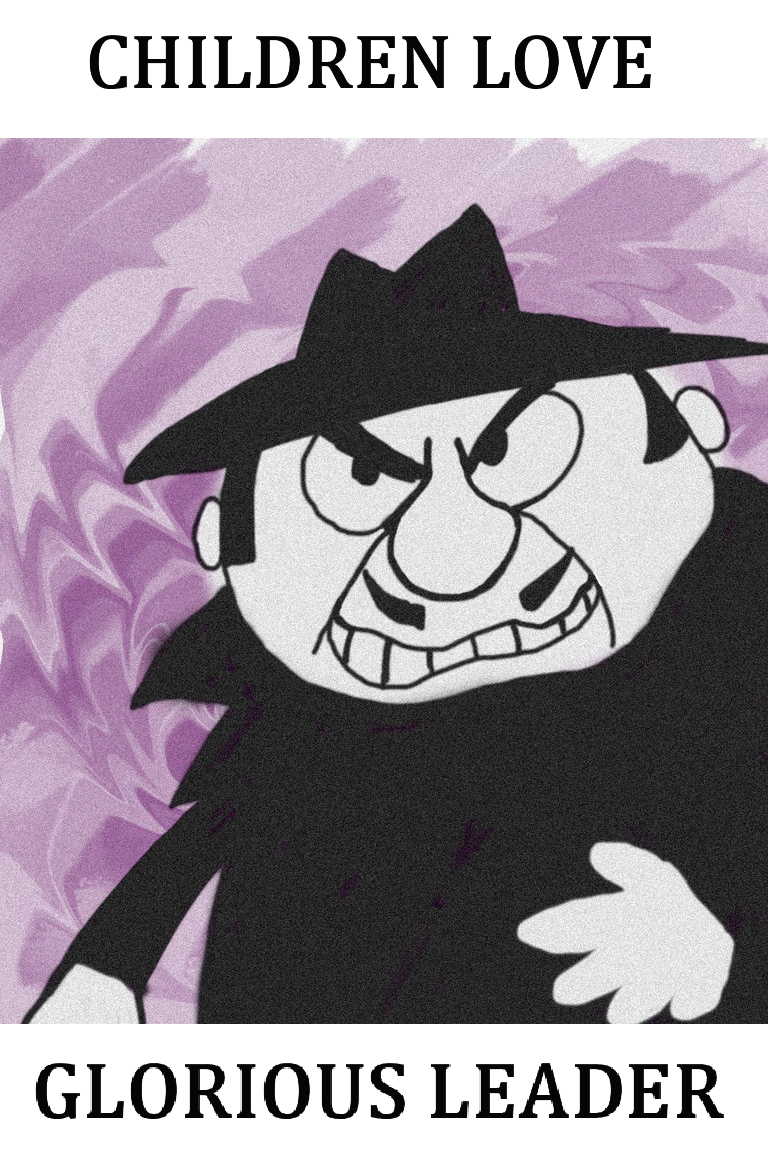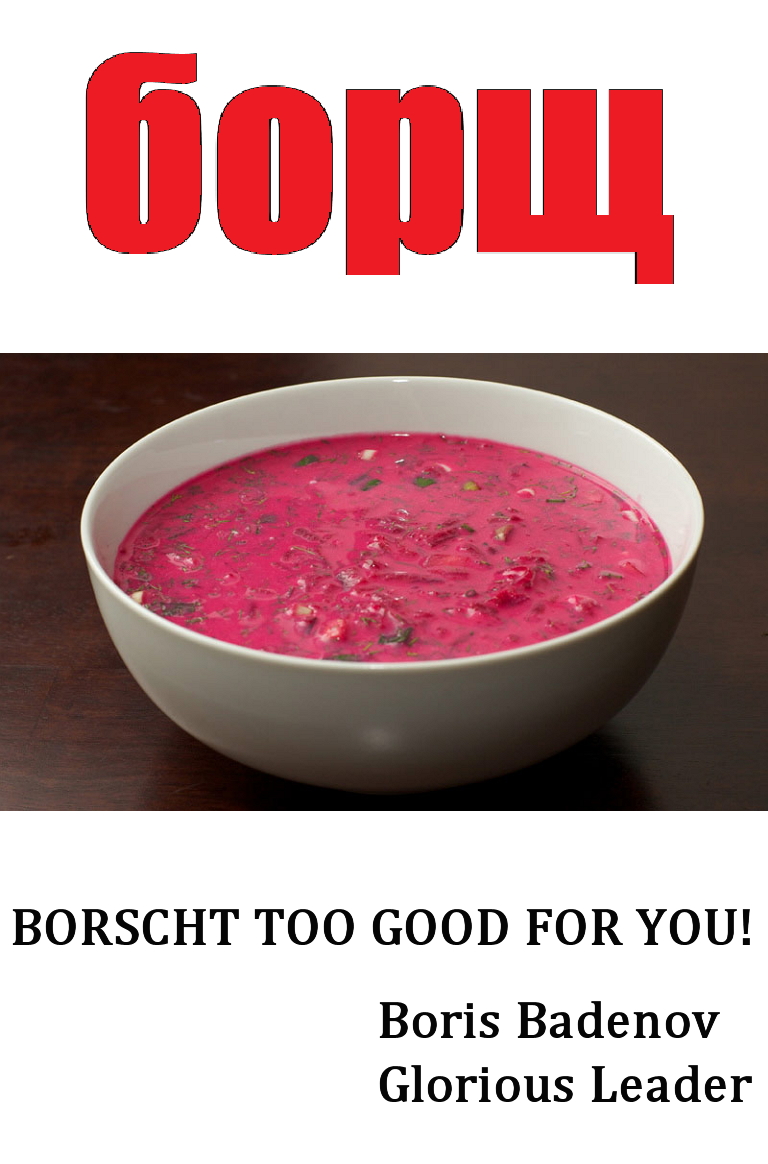The Credits
This Time For Sure: Boris Badenov's Gulag For Unrepentant Children was the production of the NELCO 2014 Build Your Own Game workshop. We had many wonderful sources of inspiration for the game:
- Alvin and the Chipmunks
- Calvin and Hobbes
- Charlotte's Web
- Dennis the Menace
- FoxTrot
- Peanuts
- Rocky and Bullwinkle
- The Great Escape
- The Muppets
- The Simpsons
We couldn't have written this game without these sources. All of these characters and their images are copyright by their individual creators, and not us, by any means. The players loved being able to play these characters, and they were clearly inspired as much as we were.
What follows is the timeline we went through to create the game.
Friday night, 8:00 PM
I give my seminar on how I write LARPs, and the processes I think about as I do my development. There is no One True Way to write LARPs, but this is what works for me and has worked for several BYOG workshops in the past.
Friday, 10:30 PM
We (Tim Lasko, Theresa Sullivan, Gaylord Tang, and I) gather in the Concord room and start to brainstorm. The goal of brainstorming is simple: throw out ideas for LARP concepts, genres, themes, and anything else that could form the nucleus of a LARP. There are no bad ideas in this process; critiques are not allowed, no matter how wacky or perverse the idea seems. Everything gets captured on a Post-It™ and put up on the whiteboard. By Friday night, there are a lot of Post-Its™ on the board, but they are all raw ideas, without focus.
This is a great start, which sets us up nicely for the real work. We get to go out and get a taste of the other discussions going on at the conference.
Saturday, 10:00 AM
Rested and ready to go, we gather in the Concord room with our equipment, our munchies, our water and sodas, and a whiteboard full of Post-Its™. The first step is to coalesce the ideas into a set of clumps. Everyone goes to the whiteboard and starts moving Post-Its™. Again, there is no "right" or "wrong" place to this process. You move the Post-It™ into a group you think it belongs with. Others may have different ideas. Post-Its™ move, but, before long, they are in one of five groups.
Four of these groups are concepts that fit together in some fashion. These are our potential LARPs. The fifth group are the Post-Its™ that don't belong anywhere else. While they may be good ideas or concepts, they have not gotten to critical mass.
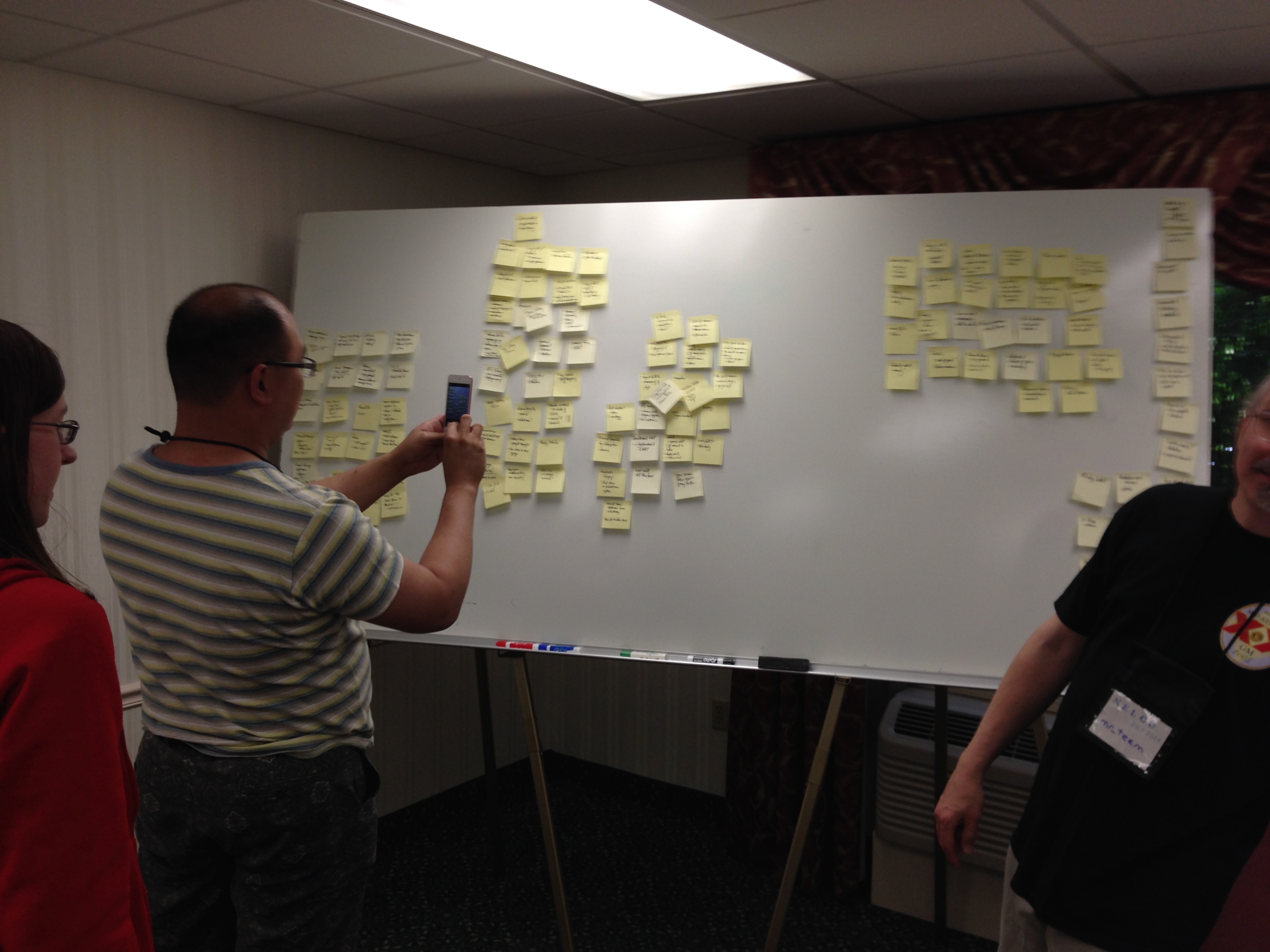
Saturday, 10:45 AM
With four potential games on the board, each one gets a more specific brainstorming session. What kinds of game does this concept represent? What themes and plots could fit into this specific idea? More Post-Its™ are added to each cluster.
One idea is serious, with some deep implications. It could also be done as a period piece, with a very distinct style that would be cool to play with.
One idea is less serious, and it flips a trope completely on its ear. There are a lot of odd possibilities and ways this could go, but there are some really good ideas.
One idea is really silly, and provokes a lot of laughter. There are tropes that everyone knows, and character ideas come easily to us.
One idea is much darker than the others, with some philosophic overtones that would be interesting to explore. It's harder to see what kind of game we could build from it, but it's definitely worth exploring.
Now comes the hard part - deciding on which one to write. Of the four, two are more appealing, so we can eliminate half of the contenders. However, it's still too close to call.
Last year's BYOG faced a similar dilemma. Rather than spend a lot of time going down what turned out to be something that wouldn't fit in the time and space we had, we continued brainstorming the two ideas. The goal was very specific - did we have enough material that we could produce something that would work for 8-12 players in two hours?
The extra brainstorming paid off. We had a concept for a game we were confident we could write, produce, and have fun doing so.
Saturday afternoon
When we went into the Concord room on Friday afternoon to move my game writing supplies into place, I noticed they'd given us their small whiteboard. That just wouldn't do, so I asked them for their bigger board. They gave us that and left the smaller one in the space. Since I can never have enough whiteboard space, I kept it.
All of the winning cluster Post-Its™ moved to the smaller board. There were ideas there that we might not use, and so only the best ones migrated to the larger board.
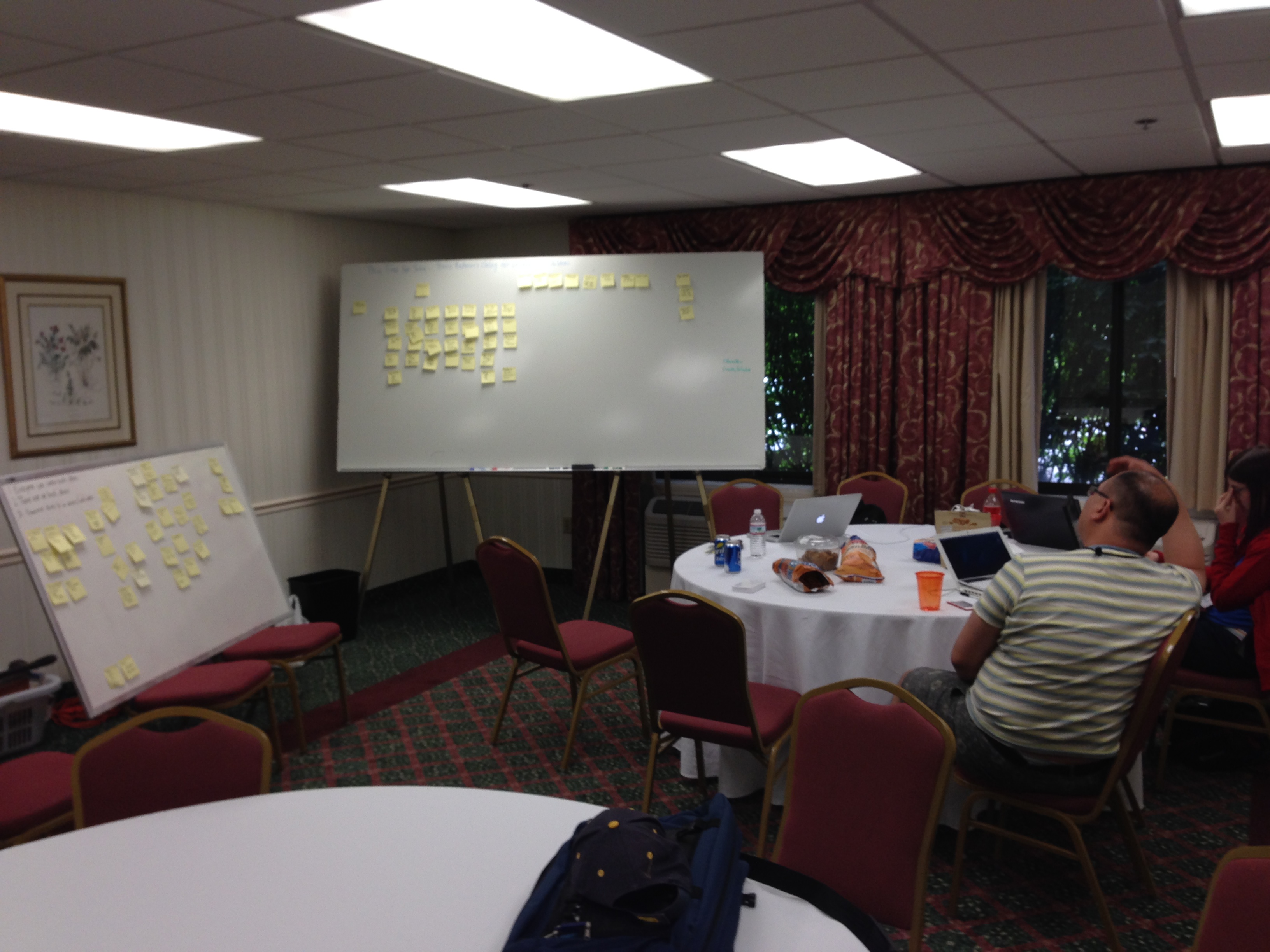
We also have a name for the LARP. This Time For Sure is from Rocky and Bullwinkle, as is our Glorious Leader Boris. (I have a special fondness for Boris, having played him in The Great Race, a weekend-long murder mystery LARP back in 1990. Tim played Moose in that LARP - or was it Squirrel?). Boris seemed to be the natural leader of a Gulag, and we had a lot of unrepentant children characters in mind.
The technology for LARP writing has matured to the point where it's really easy to collaborate.
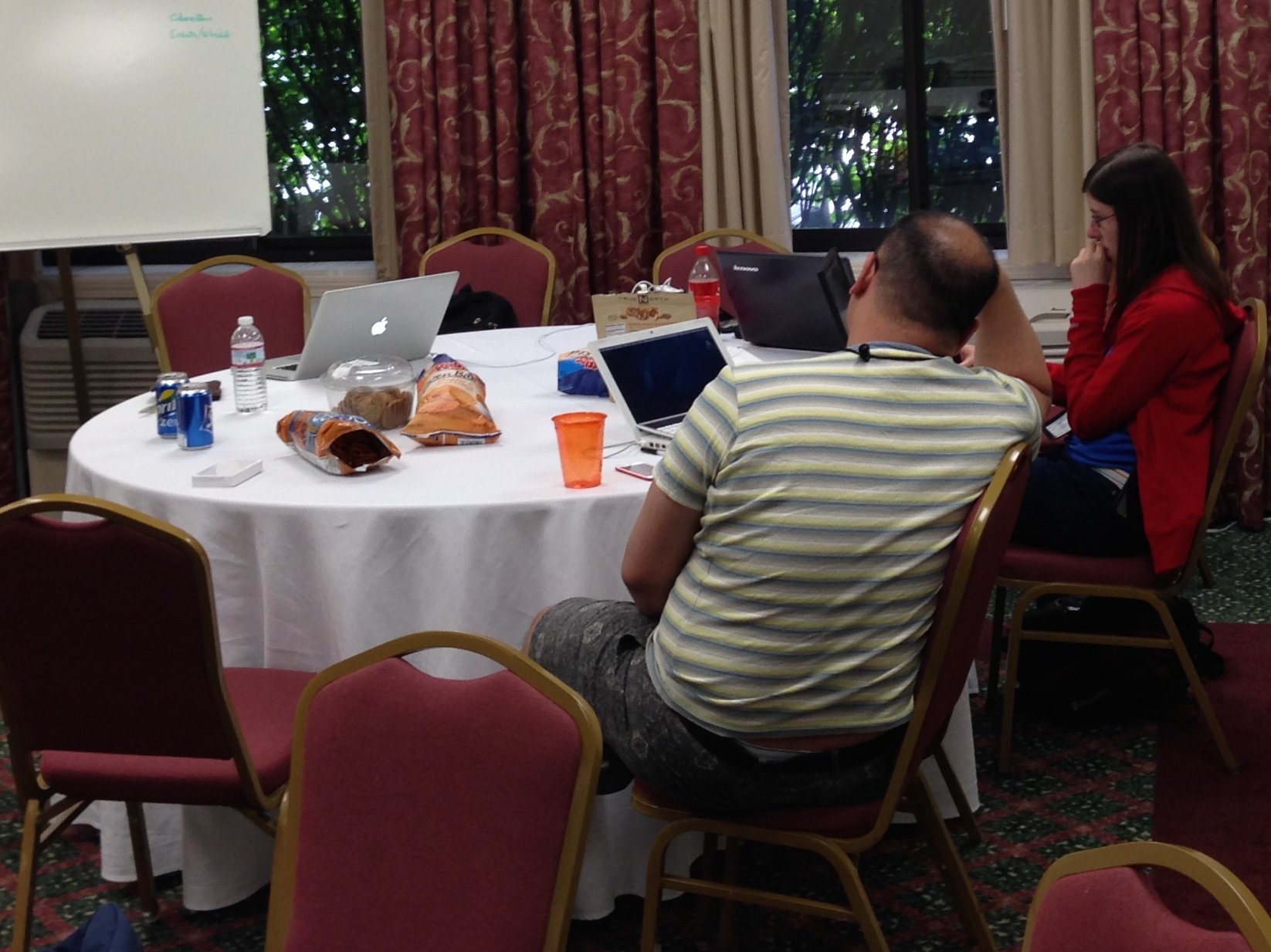
If you look closely, you can see my MacBook Pro, running OS X. I created a new Google Docs directory and shared it to the others. Theresa has her Windows laptop. Tim has his laptop that runs Windows 8. Gaylord has this Rube Goldberg contraption that marries an ancient iBook, a Bluetooth keyboard, and an iPod Touch for the display. I'm afraid to ask what he's actually running on that lashed up set of gizmos, but it works for him. With the hotel's WiFi, Dave Kapell's low-end laser printer, and my laundry baskets with LARP supplies, we have everything we need to crank out a game - including a lot more Post-Its™.
Later Saturday afternoon
We are making good progress, and spirits are high. I draw ten large squares on the whiteboard, one for each character. With four of us, that's a reasonable target to aim for.
The Post-Its™ move into specific squares, because those ideas are going to go with a specific character. For some of those Post-Its™, I make duplicates, because they are for two (or more) characters that share some plot or idea. Pink Post-Its™ represent items for the character, and there are other items that the characters might want. Blue Post-Its™ represent specific bluesheets that we need to write for some or all of the characters. Orange Post-Its™ represent tasks we need to do later in the process, so we don't forget them.
We agree on a template for the character sheets and for the bluesheets. These go into Google Docs before we go any further. We also collaborate on the blurb for the game, which goes at the top of the signup sheet. I take the signup sheet into the NELCO "con suite" space and then go back to work.
My collection of colored whiteboard markers are another useful tool. They help us to track our progress.
While this is a collaborative process, we all have our favorites from the list of characters we've decided on. Since this is Theresa's first writing effort (she's been a great GM for a long time), she gets to go first. She writes her name in brown in the square for her choice, then hands off the marker to the next person. Since I can write just about anything, I pick last. That gives us the first four characters to write - and so we start typing away.
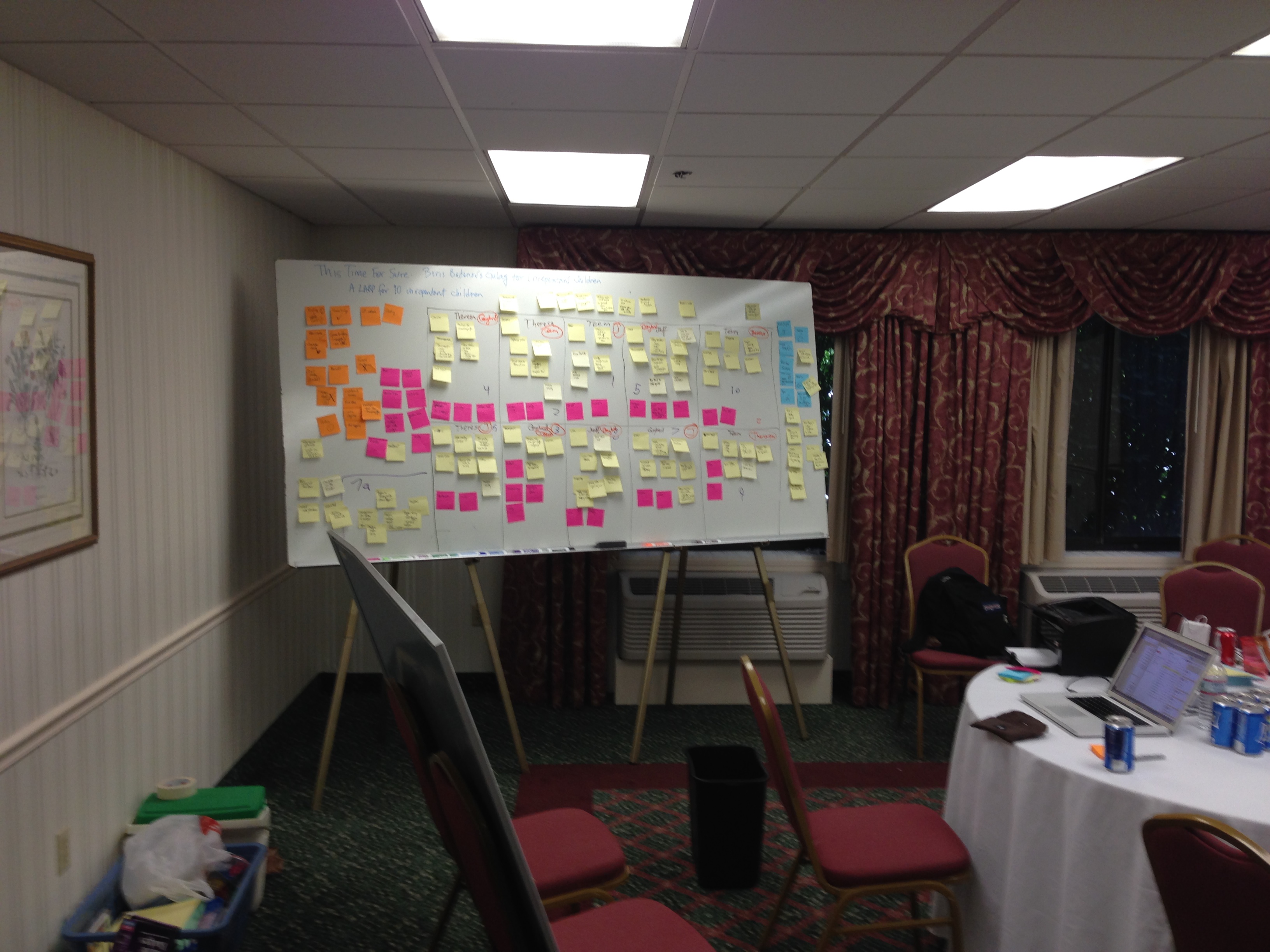
(This is what the whiteboard looks like late in the process.)
Dinnertime Saturday evening
Josh Rachlin, our Morale Officer, has been poking his head into the room on occasion, to see how we're doing, and to see if we need anything. At dinnertime, he says that we should go off and eat, and that's a great idea. We make sure the room is closed and locked, then go off for food. There are many others eating in the hotel restaurant, so that's where most of us go. It's a nice break in the middle, and we can decompress a little.
People have seen the blurb and the signup sheet, and they are excited. Nine of the ten slots are already filled. This means we really have to have something done by Sunday noon. There are expectations!
After dinner Saturday
As we write, we can look at what the others have written about our characters. Google Docs makes this trivially easy, and I have many, many tabs open in my browser. Continuity and consistency is really important in a game, so I encourage people to share as they create. There are some really clever and funny gems in the other sheets, and it's not unusual for someone to laugh as they read someone else's work.
It becomes apparent that we are terrible people. We're writing a game about doing horrible things to little kids. We're kidnapping them and throwing them into prison, ripping them from their parents, forcing them to eat noxious food, throwing them into solitary confinement when they break the rules - and we're laughing about it.
Characters are being written at a good pace. As soon as one character is finished, the author goes to the whiteboard and claims a new character to write. Theresa and Tim crank out the pages, each finishing three characters by the time they're done. Despite all my experience, I'm the slowest at this, because I tend to go on and on at great length. However, because of consistency, I'm also going into the other characters and making sure things agree.
Jen has sent me email saying that she was considering driving out in the morning, asking if there's a slot in the game. I tell her there is and she asks to take the slot. We are full!
Some time early Sunday
By the time I'm working on my second character of the game, I am the last one working on a character. That means that I hand the orange marker out and let the others make a new choice. They get to pick someone else's character to read to look for goofy sentences and do consistency checking. They write their name on the board in the character they're checking. When they're done, they pick a new one to check.
After finishing two characters, Gaylord takes a crack at the list of bluesheets we need, and he just cranks through them. We do consistency checks on them as well.
As we are going through the characters, we are generating new Post-Its™ for the board. These are almost all entirely orange, for the things we're going to have to do to assemble the game. There are also a list of things we need to get at the Staples down the road, when they open at 10 AM.
Later that Sunday morning, but still before dawn
Tim has found images to use to make the Glorious Leader and Borscht posters for the game space. He and Theresa have done the Google Docs table magic to define all of the item cards, as well as the name badges. Gaylord's singing The Spontaneous Song of Praise for the Glorious Leader. I'm not sure where the list of Red Star tasks came from, but they're impressive. I've collected the list of information we want to give in the game briefing.
That means it's time to print. There is a slight moment of panic when the printer is a little slow to get started, but then it gets going.
Part of my condo looks like a Staples warehouse, and two laundry baskets of that have come along with me. This includes several different colors of paper and cardstock. There's also my stapler, my hole-punch, and my papercutter.
As I print each document in the game, I make a list in another document. I write down how many copies we need of each page, along with the kind of paper I'm printing it on. For pages that go to some subset of the players, I make a note of who gets those pages. This is an important sanity check for all of us, who are in a sleep-deprived state, forcing us to think carefully about what we need. We also want to be able to run the game again - and if there are already instructions on how to assemble it, we won't be confused.
There is also an extra copy of every page, which goes into the GM Bible for the game. The GM Bible is the notebook with all of the game materials in it, which we can use at runtime as a reference. We can also pull pages out of it if someone loses something.
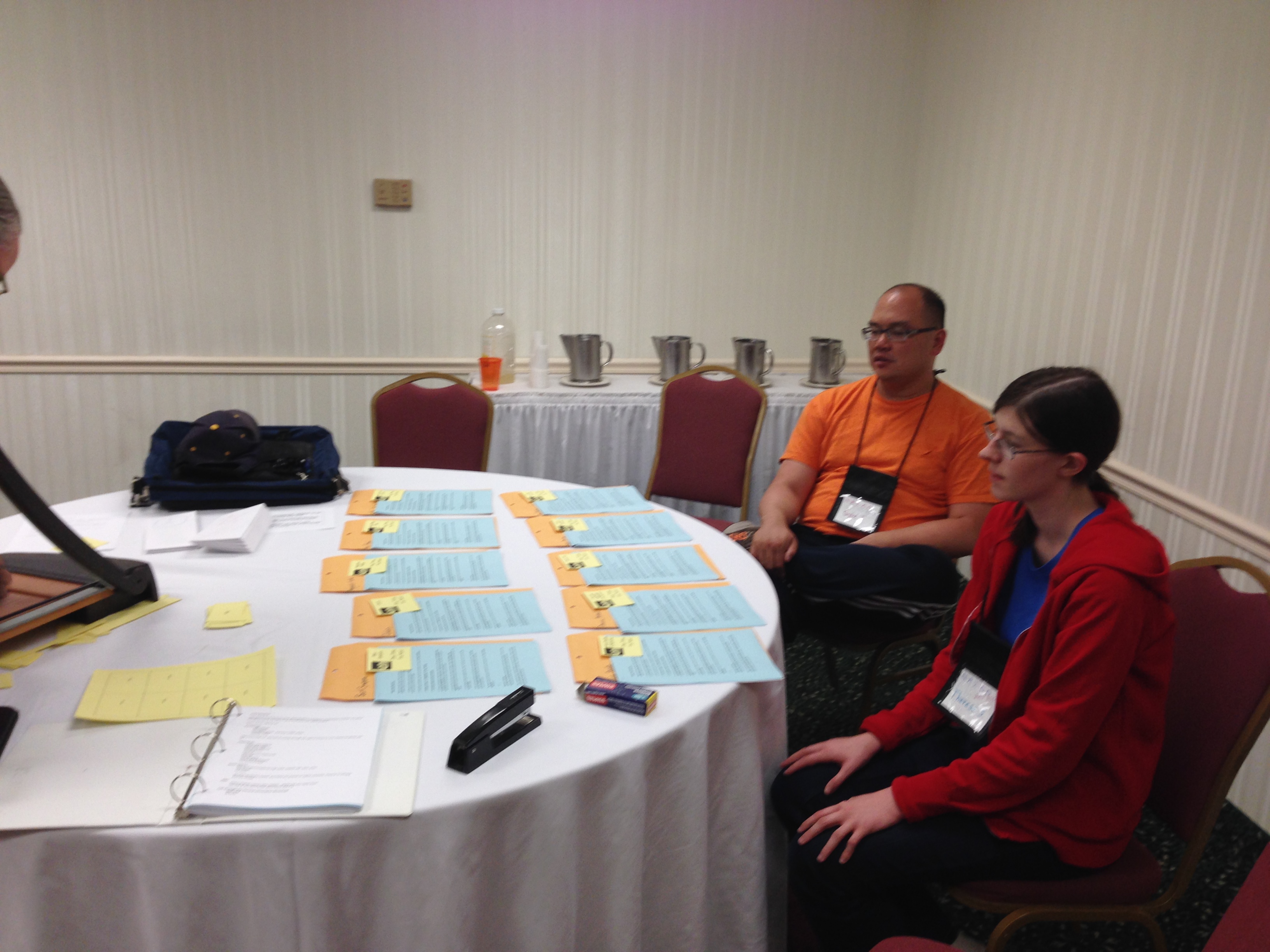
Printing leads to collation. (by Gaylord and Theresa) Collation leads to character packets and the GM Bible. The GM Bible leads to the Dark Side... er, uh, never mind.
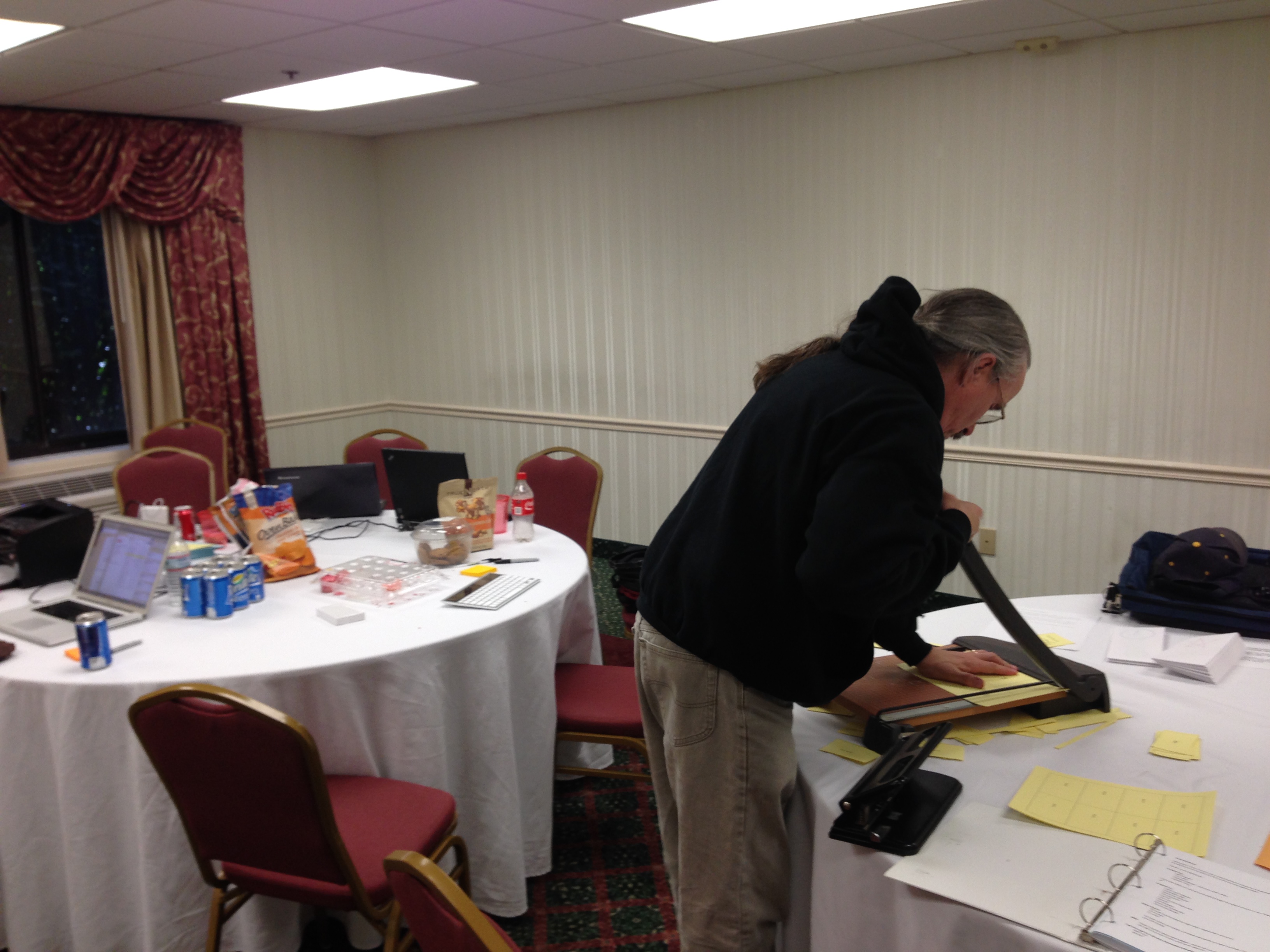
And, as Tim knows well from my other games, there is much slicing.
Sunday morning, 8 AM
Everything that can be done is finished.
All that's left to do is to make a run to Staples, figure out who's playing what part, and then set up the room. With four hours to go, that's a stunning surprise. There will be time to take showers and clean up before the game. There will be time to get breakfast. What could go wrong?
Sunday morning, 10:30 AM
The Staples list is short:
- Art supplies (crayons and construction paper)
- Red Star stickers
- Another kind of sticker, different from stars
- Two cardboard boxes
- Color copies of the poster pages
Easy, right?
They have no sheets of red stars. They have sheets of stars that have a few red stars on every page. They have red dots. They have shiny, glittery multicolor stars.
The clerk suggests going to Michael's next door, so I pay for the stuff. Tim takes it to his car while I walk down to Michael's. They have two aisles of stickers and a different teacher's section of supplies, but there's not a single red star among them. Great. I go back to Staples, buy several sheets of the ones with some red stars, and we're done. Except I've lost Tim somewhere.
A quick text message solves that problem, and we're heading back to the hotel.
There's a little more packet stuffing, but that's easy. All of our work looks like nothing when it's packed and ready for the game.
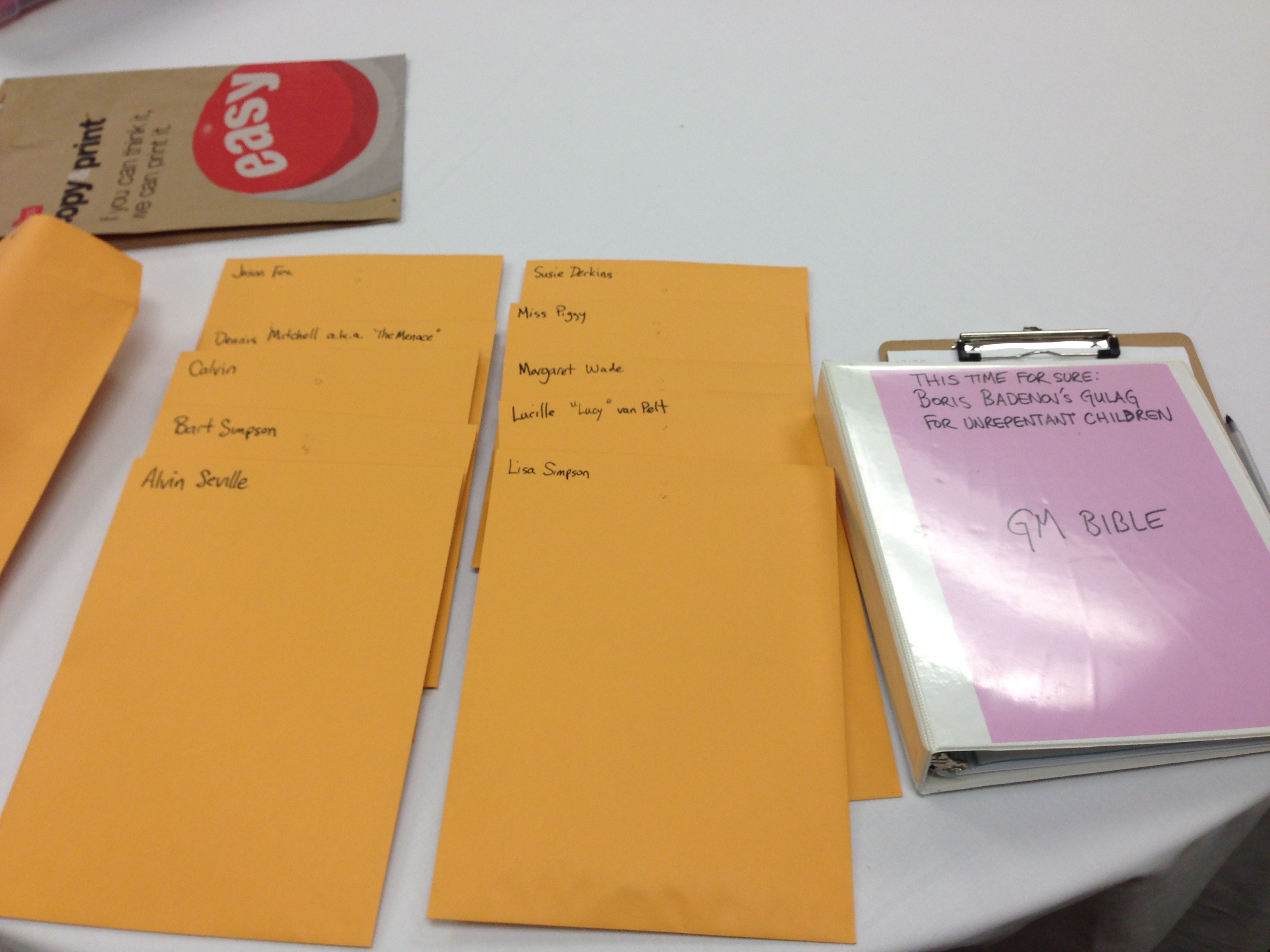
Sunday morning, 11:30 AM
The four of us have reassembled. I have the signup sheet, and between the four of us, we only recognize half the names. We need to cast the game, so we need to figure out the black magic of putting the right people into the right roles. We go to look for the players. One of the unknown players is with someone I know, so I am introduced. I ask him a few quick questions, and get a better sense of where he'll fit. Dave Kapell knows two of the other unknown players, and he gives me enough to work with. That leaves two people no one seems to know.
There are times you have to take a chance on an unknown player or two, so we went down the list. There were a few obvious choices for the people we knew, and we guessed at the others. Our casting was complete.
Sunday morning, Noonish
Tony Mitton has a great rant called Players Are Scum. He goes on at some length about how players cause GMs utter grief. One ulcer-inducing act is when players drop and don't tell you about it. Two of our players decided they were going to leave the hotel early, and we didn't get the message until very close to game time. Now we were two players short - and this is not a game designed for flexibility. We needed everyone - so we started looking around for anyone who was available. Fortunately, we found two people willing to step in and help us out.
Sunday afternoon, 1:15 PM
We started later than expected. Two of our unknown players got parts that they considered great casting. Everyone had great fun with their roles, and we had a blast as GMs working through our carefully crafted plans. There are a few rough spots, but we're all experienced GMs; we could work around them and make notes of what we need to improve for the future.
Afterword
In just over 22 hours, we created a game that players left with big smiles, talking excitedly about their characters, their interactions, and the fun they had. I'm proud of what we produced in such a short time. I loved working with Tim Lasko, Theresa Sullivan, and Gaylord Tang, and would happily do so again. We also appreciate Josh Rachlin for his efforts as Morale Officer.
Writing a successful LARP is always a challenge - and we did good. I look forward to future runs of This Time For Sure: Boris Badenov's Gulag for Unrepentant Children.
